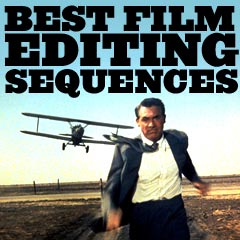
|
| Film Title/ Director & Editor and Film Description | ||
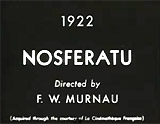 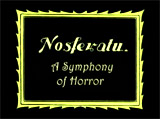
|
Nosferatu, Eine Symphonie des Grauens (Nosferatu, a Symphony of Horror/Terror) (1922, Germ.) d. F. W. Murnau Murnau's film was an unauthorized film adaptation of Stoker's Dracula with Max Schreck in the title role as the screen's first vampire - a mysterious aristocrat living in a Transylvanian castle in distant Bremen named Count Graf Orlok (Max Schreck). In this vampire horror film's most dramatic sequence, the emaciated, balding undead vampire's image was unforgettable with a devil-rat face, pointy ears, elongated fingers, sunken cheeks, and two long toothy fangs. He was seen first at a distance, but then quickly approached (through dissolves) toward the horrified visiting real estate agent Johannes Hutter (Gustav von Wangenheim) until he was completely in the curved, pointed doorway with a Gothic arch, revealing his ugly, scary figure. |
 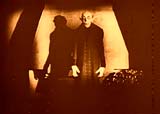 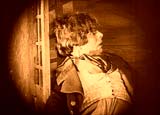 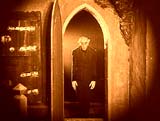 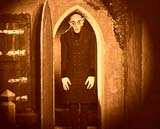
|
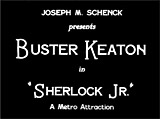
|
d. Buster Keaton Stone-faced director/producer Buster Keaton starred as a lovelorn film projectionist named Sherlock Jr. who wanted to be a detective, in this marvelously inventive, silent film comic fantasy. There was a series of quick, jump-cutting film edits and an abruptly-changing montage of scenes behind him when he fell asleep in the projection booth and a ghostly dream version of himself left his body and walked around the theatre (unnoticed) and then stepped into the 'silver screen' and magically became part of the projected shifting scenes, a 'movie in a movie.' He walked down stairs and fell over a garden bench or pedestal, found himself on a busy street, a mountainous precipice, a lion's den, a desert in the middle of tracks with an approaching train, and a rock surrounded by the ocean where he dove headfirst into a snowbank, and then returned to the opening garden where again he fell over the garden bench. |
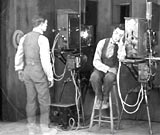 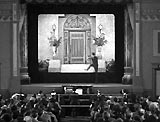 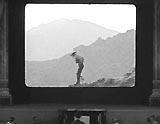 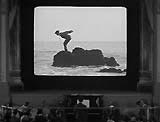
|
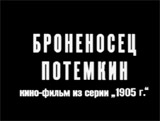
|
Battleship Potemkin (1925, Soviet Union) (aka Броненосец Потёмкин) d. Sergei Eisenstein Legendary Russian auteur director Sergei Eisenstein's classic landmark and visionary film was released in the US in 1926, advancing the art of cinematic storytelling with the technique of montage (or film editing). Two or more distinct shots were merged together to create a new meaning by their juxtaposition. Its most celebrated film scene, with superb editing combining wide, newsreel-like sequences inter-cut with close-ups of harrowing details to increase tension, was the Odessa Steps episode. The sequence was based upon the incident in 1905 when civilians and rioters were ruthlessly massacred. It was beautifully orchestrated with a montage of close-ups of faces and objects and long-shots, all rapidly cut together and contrasted as the images built to a devastating conclusion. In the scene (with 155 separate shots in less than five minutes), successive waves of white-uniformed soldiers appeared, ordered by city officials loyal to the czar to attack the riled-up citizenry. Shots rang out as they fired on the civilians, bringing about dizzying chaos as terrified people rushed to flee down the steep stairs. One woman, whose son had been shot, cradled his bloodied body in her arms and approached the army to defy them. She stood in their elongated shadows before she too was gunned down point-blank. A young mother was hit in the mid-section, and the force of her falling body caused her baby carriage to tumble out of control down the steps, in an indelible image (copied by Brian De Palma's The Untouchables (1987) and by Terry Gilliam's Brazil (1985)). And in a startling close-up, the lens of a woman's glasses splintered and blood gushed from her eye socket. |
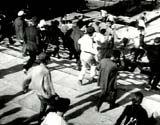 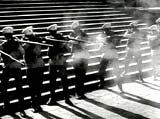 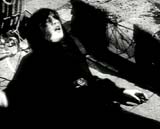 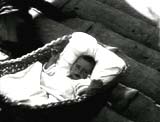 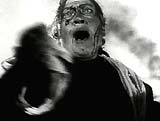
|

|
October (Ten Days that Shook the World) (1928, Soviet Union) (aka Oktyabr, or Октябрь) d. Sergei Eisenstein This film re-enacted in documentary-style, the days surrounding the Bolshevik Revolution, to commemorate the event's 10th anniversary. Its most famous sequence was a series of shots of the pre-Lenin (pre-revolutionary) provisional government leader George Kerensky climbing a series of stairs - his ascent to power, interspersed with titles and images that ridiculed his presumptive grandeur (a mechanical peacock preening itself). Another sequence was an 'intellectual montage' of images of various world's religions' deities, juxtaposed with a baroque image of Jesus. |
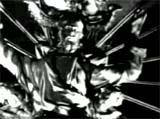 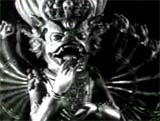 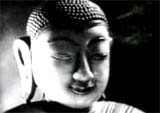 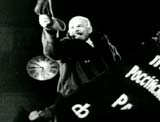
|
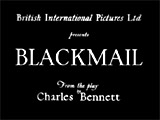
|
Blackmail (1929, UK) d. Alfred Hitchcock Hitchcock's film was the first British all-talkie feature film, although it was originally made as a silent picture and then converted through dubbing. In the opening fast-paced sequence of this thriller, a crook was arrested in his room, fingerprinted, and jailed by the police (with the passage of time indicated by cigarette butts in an ashtray). Hitchcock also used visuals to subjectively imply other things -- a young, guilt-ridden murderess Alice White (Anny Ondra) killed overzealous admirer Mr. Crewe (Cyril Ritchard) with a large bread knife when he sexually assaulted her in his attic artist's studio. Afterwards, she saw a neon sign advertising Gordon's Gin cocktail mix being shaken up, but she interpreted it as the up-down stabbing motion of a thrusting knife. And the film contained the first example of a "jump cut" or "shock cut" when Alice's scream merged with the landlady's discovery of the body. Later, the film innovatively used sound to heighten the tension in the famed family breakfast scene. The word "knife" was repeated and amplified in the gossipy conversation about the murder, heard from Alice's rattled point of view:
When Alice picked up the knife to slice bread, the word knife was amplified into a loud scream, causing the knife to leap from her hands, with her father cautioning: "You might have cut somebody with that." |
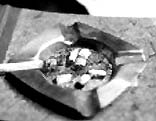 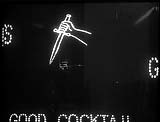 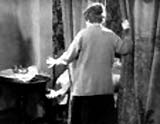 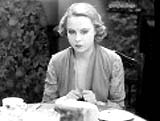 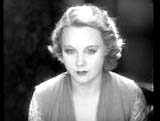 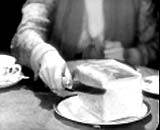
|
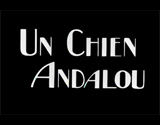
|
Un Chien Andalou (1929, Fr.) (aka An Andalusian Dog) (short) d. Luis Buñuel, Salvador Dali This shocking, and provocative surrealistic film of the 1920s avant-garde movement, only 17 minutes long, was filled with irrational, freely-associated and shocking images juxtaposed without any sense of logical continuity or narrative, to produce powerful effects due to the editing. It was banned in various countries, mostly for its infamous eyeball razor-slashing scene in the opening. After a title card reading: "Once upon a time," a middle-aged "husband" (Luis Buñuel) sharpened his razor and then held his "wife" (Simone Mareuil) as he slit her eye with the cutting instrument.
The sequence was intercut with another shot, viewed from the balcony, of the full moon as it was sliced or bisected by clouds moving from right to left. |
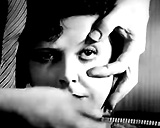 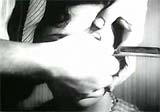  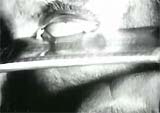
|
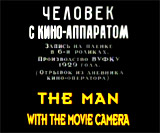
|
The Man With a Movie Camera (1929, Soviet Union) (aka Chelovek s Kino-Apparatom, or Человек C Kино-Aппаратом) d. Dziga Vertov At the end of the decade, this influential and creative avante-garde film from experimental cameraman/director Dziga Vertov employed some of the first uses of the split screen, montage editing, stop-motion, extreme close-ups, and rapidly-filmed scenes in its presentation of views of Moscow and other cities (Kiev, and Odessa). Every modern movie convention was demonstrated in this film, as it showed the roles of the cameraman and the editor in the creation of a film during one day. The fast-moving, free-association of images (over 1,700 shots and scenes of everyday life), all presented with an average of 2.3 seconds per shot length - was wholly unprecedented in the late 1920s. It was an excellent example of a "city symphony" documentary, regarded as "pure" visual cinema, in its prresentation of Soviet workers and machines. Vertov's film contained radical hyper-editing techniques, special visual effects, wild juxtapositions of images, freeze frames and double exposures. The film's most famous double-exposure sequence was the camera-trickery shot of a cameraman setting up his camera atop another camera. The best example of stop-motion were the playful views of the tripod-camera acting anthropomorphically, by rotating its camera-head around, and then beginning to walk away on its three legs. In its ending, there were some views of the actual process of the editing of the film by the cameraman, accentuated by the super-imposed image of a human eye looking out of a camera lens. |
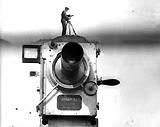 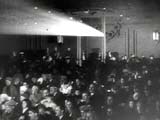  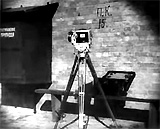 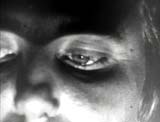 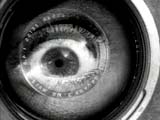
|